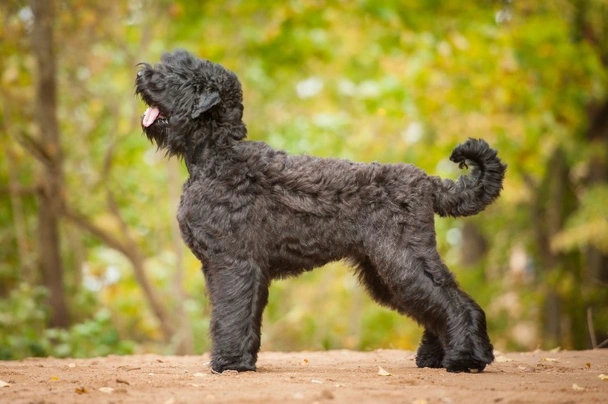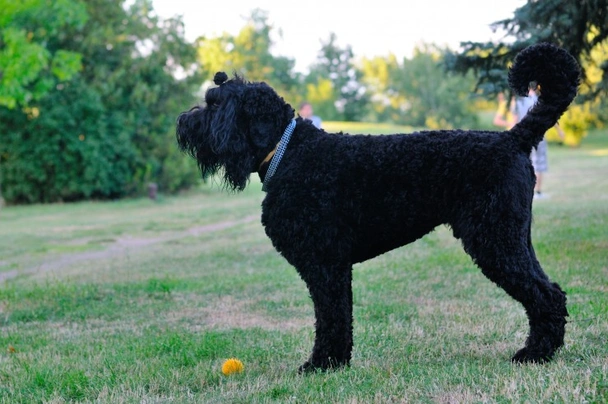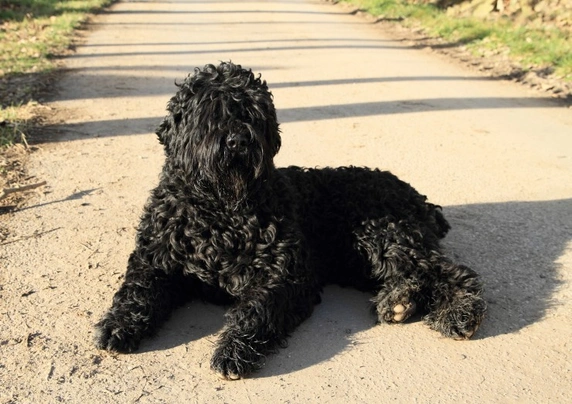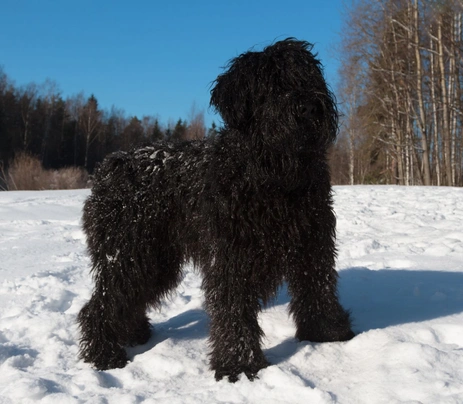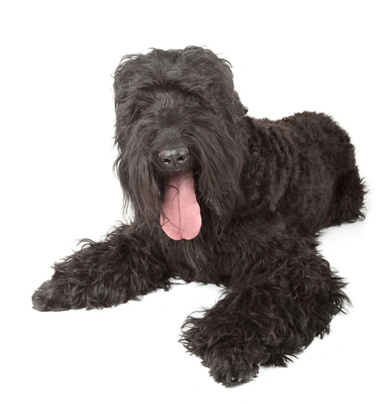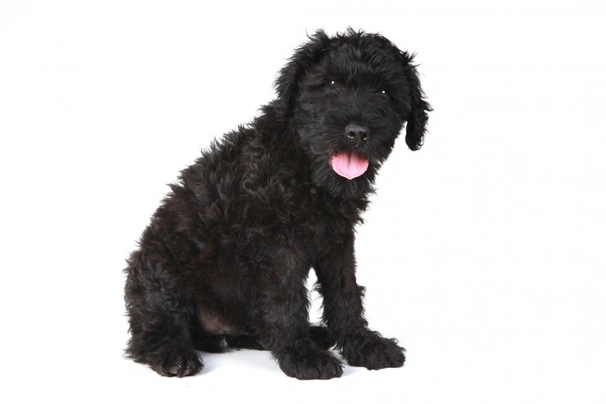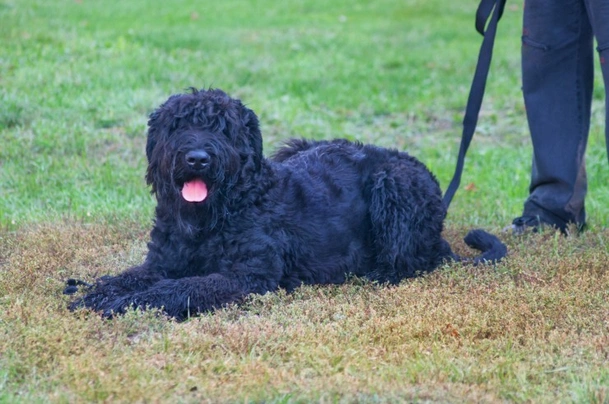Russian Black Terrier
Pros
Cons
Introduction of the Russian Black Terrier
The Russian Black Terrier is a large and impressive looking dog and one that was specifically bred by the Russian army to track down fugitives and guard properties. Also known as the RBT these attractive dogs have been highly prized in their native Russia as well as other countries but more especially in Italy. However the Russian Black Terrier is less popular in the UK although they make wonderful companions and family pets thanks to their kind loyal and affectionate natures.
With this said anyone wanting to share a home with an RBT would need to register their interest with breeders and go on a waiting list for the pleasure of doing so. The good news is that the wait would be well worth it. However Russian Black Terriers are better suited to people who are familiar with the needs of such an intelligent high-energy dog.
History of the Russian Black Terrier
The Russian Black Terrier or RBT as they are often called was first developed by the Russian Army at the end of World War II when they needed a dog that would be able to work and track down fugitives in harsh conditions. The three main breeds used to create these large and impressive looking dogs were Giant Schnauzers Rottweilers and Airedale Terriers with many of the dogs being imported by the Russian military to be used in their breeding programmes and the RBT was originally bred solely by the state-owned Red Star Kennels. However some puppies were sold to non-state breeders who then began to develop the breed both in Russia and outside of the country.
They have always been highly prized in Russia not only as being highly skilled and courageous working dogs but as faithful loyal companions and family pets too. They also found a big fan base in Italy during the late eighties for the same reason and the breed was eventually recognised by many international breed clubs which included The Kennel Club. However there was a lot of debate as to what the breed should be called and in which group these large dogs should be placed. They were eventually given the name of Black Russian Terrier and put in the Working Group.
Anyone wishing to share their home with a Black Russian Terrier would need to register their interest with breeders because so few well-bred pedigree puppies are available every year but the wait is well worth it.
Interesting facts about the breed
- Is the Black Russian Terrier a vulnerable breed? No although quite rare in the UK and therefore puppies can command a lot of money
- They were used by the Red Army as military dogs in their native Russia
- They are also known as The Black Pearls of Russia
- The breed is still considered rare in the UK and elsewhere in the world
- Traditionally a Black Russian Terrier's tail was always docked but since the law banning the procedure came into effect in 2007 tail docking is now illegal with the exception being for some working breeds and if a dog suffers from some sort of health issue that requires their tails to be docked. The procedure must be agreed and authorised before being performed by a qualified vet
Appearance of the Russian Black Terrier
Height at the withers: Males 64 - 70 cm Females 66 - 72 cm
Average weight: Males 45 - 68 kg Females 36 - 59 kg
The Black Russian Terrier looks very much like the Giant Schnauzer only they are a lot bigger. They are strong courageous and athletic looking albeit quite imposing. With this said they are well proportioned with strong robust frames and virtually square bodies. They have nicely proportioned heads with broadish skulls and rather full cheekbones. Their eyebrows are a little pronounced adding to a dog's charming looks. Their skulls are flat and dogs have moderate stops with the top of their muzzles being in line with the top of their skulls. Muzzles taper slightly towards a dog's nose and boasts having nice whiskers and beards which squares off their muzzles nicely. Noses are large and black in colour with dogs having thick black lips.
Their eyes are oval in shape moderately large and dark in colour being set obliquely and wide apart on a dog's face. Their eyelids are tight fitting and dark too. Ears are set high and pendant being triangular with the inner edge touching a dog's cheekbone. The Russian Black Terrier has a strong jaw with a perfect scissor bite where their upper teeth neatly overlap their lower ones.
They have quite long well-muscled and powerful clean cut necks that merge smoothly into a dog's shoulders which are nicely laid back. Front legs are straight and muscular. The Russian Black Terrier boasts having a compact powerful looking body with clearly defined withers and nice muscular level backs. Chests are deep and ribs well sprung with bellies being moderately tucked up which adds to their athletic appearance.
Loins are short and wide being slightly arched and well-muscled. Their back-ends are well developed and large with a slight slope towards the tails. Back legs are straight and set wider apart than a dog's front legs having well developed and muscular thighs. Their feet are large and round with well arched toes and firm thick pads with strong black nails. Tails are set high on a dog's croup being thick which dogs can carry curled over their backs.
When it comes to their coat the Russian Black Terrier boasts having a very weather resistant double coat that's neither soft nor is it wiry. Their undercoat is very dense with dogs having lots of furnishings on their faces which forms their eyebrows and beards. Their legs are nicely furnished too. The accepted breed colours for Kennel Club registration is as follows:
- Black
- Black with grey hairs evenly distributed throughout a dog's coat
Gait/movement
When a Russian Black Terrier moves they do so with a positive purposeful gait moving their legs in a straight line as their front legs converge slightly. They have an "elastic" movement and cover a lot of ground at all paces showing a lot of reach in their forequarters and plenty of drive from behind.
Faults
The Kennel Club frowns on any exaggerations or departures from the breed standard and would judge the faults on how much they affect a dog's overall health and wellbeing as well as their ability to perform.
Males should have both testicles fully descended into their scrotums and it is worth noting that a dog can be a little lighter or heavier as well as slightly taller or shorter than set out in the Kennel Club breed standard which is only given as a guideline.
Temperament of the Russian Black Terrier
The Russian Black Terrier was bred to guard which is a trait that's deeply embedded in their psyche. They are highly intelligent and therefore in the right hands and environment they are easy to train but they are not the best choice for first time owners. They are best suited to people who are familiar with the particular needs of this type of large and intelligent dog and who therefore know how to handle them.
They are known to be lively and confident even-tempered dogs that are naturally wary of people they have never met before. However although they have a strong instinct to protect and guard their owners and their property rarely would a Russian Black Terrier show any sort of aggressive behaviour towards a stranger preferring to keep their distance and let their owners know there are people about.
Puppies need to be taught the basics as soon as they arrive in their new homes so they understand the boundaries and limits. It's easier to teach a puppy than it is a very large dog. Their socialisation also must start early and it should include introducing puppies to lots of new situations noises people other animals and dogs once they have been fully vaccinated so they mature into well-rounded adult dogs. A good way of socialising a dog and starting their training in earnest is to enrol them into puppy classes where they get to meet lots of other dogs and people in a safe and controlled environment.
Russian Black Terriers form strong bonds with their owners and although they can be strong willed at times they are usually obedient and like nothing more than to please. However it's important for the BRT to know their place in the pack and who is the alpha dog in a household or they may take on this role which can make it a lot harder to manage such large dogs. They do not like to be left on their own for any length of time and if they are a BRT could well suffer from separation anxiety which could lead to them becoming neurotic and stressed out. As such they are best suited to households where at least one person stays at home when everyone else is out of the house so they are never left on their own for longer periods of time.
Being so intelligent they are quick learners with the downside being a BRT is just as quick to pick bad habits and behaviours which is why their training must start early and it should be consistent throughout a dog's life so they know what their owners expect of them. They love having something to do and are never happier than when they are kept busy. As such they are best suited to people who lead active outdoor lives and ideally live in a more rural environment. Blackies boast having a high prey drive so it's important to only let dogs off their leads in safe and secure environments and preferably away from livestock and wildlife.
Are they a good choice for first time owners?
Black Russian Terriers are not the best choice for first time dog owners because they are better suited to people who are familiar with their specific needs bearing in mind they are high-energy intelligent dogs that have a low boredom threshold.
What about prey drive?
Although BRTs are very social by nature they are terriers and as such they have a high prey drive which is a trait that is deeply embedded in their psyche. As such care should always be taken as to where and when they can run off the lead more especially when there is livestock or wildlife close by.
What about playfulness?
Black Russian Terriers have a very playful side to their natures and love to entertain and be entertained. They are known to be a little mischievous when the mood takes them and being so clever they quickly learn what pleases an owner and how to get their way.
What about adaptability?
Black Russian Terriers are better suited to people who have large secure back gardens a dog can roam in whenever possible. The fencing must be very secure to keep these dogs safely in. As such they are not suited to living in an apartment.
What about separation anxiety?
BRTs form extremely strong ties with their families and are never very happy when they find themselves left on their own for longer periods of time. They are better suited to people who either work from home or in households where one person stays at home when everyone else is out so they are never alone for any length of time which could see a dog suffering from separation anxiety. This can lead to them being destructive around the home which is a dog's way of relieving any stress they are feeling and a way to keep themselves occupied and entertained.
What about excessive barking?
BRTs are known to like the sound of their own voices a little too much which is something that needs to be gently nipped in the bud when a dog is still young being careful not to frighten them. The problem is that they just love to voice an opinion which can lead to problems more especially when they are left to their own devices for too long.
Do Russian Black Terriers like water?
Most BRTs love swimming and will take to the water whenever they can more especially when the weather is hot. It's important to thoroughly dry off a dog's coat once they've been in the water because if moisture gets trapped in it it could lead to a skin allergy flaring up. With this said anyone who owns a dog that does not like water should never force them to go in because it would just end up scaring them and care should always be taken when walking a BRT off the lead anywhere near more dangerous watercourses just in case a dog decides to leap in and then needs rescuing because they cannot get out of the water without help.
Are Black Russian Terriers good watchdogs?
BRTs are natural watchdogs because they are always on the alert and quick to let an owner know when something they don't like is going on in their surroundings and when strangers are about. However rarely would a terrier go about this aggressively preferring to keep their distance and bark which is something they love to do.
Intelligence / Trainability of the Russian Black Terrier
Black Russian Terriers are intelligent athletic active dogs and as such they learn new things very quickly. With this said they are independent thinkers which means their training should not only start early but these large dogs need to be handled with a firm fair and gentle hand right from the word go. They do not answer well to any sort of harsh correction or heavier handed training methods but they do respond very well to positive reinforcement which always brings the best out of these smart and quick-thinking dogs.
Training sessions should be kept as interesting as possible because if things get too repetitive a Blacky would quickly get bored which can make training them more of a challenge. Shorter and more interesting training sessions will keep these intelligent dogs focused especially if they know they are going to receive a high value reward for getting things right. It's important to pay particular attention to the recall command right from the outset of their training so that when a BRT is let off their leads there's a better chance of them coming back when called. In the right hands and with the correct amount of training a Russian Black Terrier excels at all sorts of canine sports which includes activities like obedience agility and tracking which they thoroughly enjoy.
Black Russian Terrier puppies like all puppies are incredibly cute and it is all too easy to spoil them when they first arrive in their new homes. However BRT are also very smart and therefore they learn new things fast which includes the good and the bad. As such owners should always start out as they mean to go on once a puppy is settled in.
This means setting out rules and boundaries so that a puppy understands what is expected of them. It also helps establish a pecking order and who is "alpha dog" in a household. If an BRT puppy gets away with too much they can develop a condition known as small dog syndrome which makes them harder to manage and live with. The first commands a puppy should be taught are as follows:
- Come
- Sit
- Stay
- Heel
- Quiet
- Leave it
- Down
- Bed
Children and other
Black Russian Terriers may be large dogs but they are gentle when they are around children of all ages. However due to their size it's essential that any interaction between toddlers and a dog be well supervised by an adult to make sure playtime does not get too boisterous which could end up with child being knocked over albeit by accident. They can be a little over protective of children which is something that needs to be gently curbed when dogs are still young. It’s essential to keep a watchful eye on them when the kids have friends over to play.
They can be a little "off" with other male dogs which is why it's so important for a Russian Black Terrier to be well socialised from a young age. With this said they are generally fine around smaller dogs. If they have grown up with a family cat in a household they usually get on well together but if they would think nothing of chasing off any cats they don't know. Care should be taken when an BRT is around smaller animals and pets because they might just see them as "fair game". As such any contact is best avoided.
Health of the Russian Black Terrier
The average life expectancy of a Russian Black Terrier is between 10 and 11 years when properly cared for and fed an appropriate good quality diet to suit their ages.
The BRT is known to suffer from a few hereditary health issues which are worth knowing about if you are planning share your home with one of these active and good looking dogs. The conditions that seem to affect the breed the most include the following:
- Urate urolithiasis - genetic test available
- HUU (Hyperuricosuria) - test available through the Animal Health Trust (AHT)
- Hip dysplasia - dogs must be hip scored
- Elbow dysplasia - Breeders should have stud dogs tested
- Juvenile Laryngeal Paralysis & Polyneuropathy - DNA test available through the BVA
- Ear infections
- Allergies
What about vaccinations?
BRT puppies would have been given their initial vaccinations before being sold but it is up to their new owners to make sure they have their follow-up shots in a timely manner with the vaccination schedule for puppies being as follows:
- 10 -12 weeks old bearing in mind that a puppy would not have full protection straight away but would be fully protected 2 weeks after they have had their second vaccination
There has been a lot of discussion about the need for dogs to have boosters. As such it's best to talk to a vet before making a final decision on whether a dog should continue to have annual vaccinations which are known as boosters.
What about spaying and neutering?
A lot of vets these days recommend waiting until dogs are slightly older before spaying and neutering them which means they are more mature before undergoing the procedures. As such they advise neutering males and spaying females when they are between the ages of 6 to 9 months old and sometimes even when a dog is 12 months old.
Other vets recommend spaying and neutering dogs when they are 6 months old but never any earlier unless for medical reasons. With this said many breeds are different and it is always advisable to discuss things with a vet and then follow their advice on when a dog should be spayed or neutered.
What about obesity problems?
Some Black Russian Terriers gain weight after they have been spayed or neutered and it's important to keep an eye on a dog's waistline just in case they do. If a dog starts to put on weight it's important to adjust their daily calorie intake and to up the amount of exercise they are given. Older dogs too are more prone to gaining weight and again it's essential they be fed and exercised accordingly because obesity can shorten a dog's life by several years. The reason being that it puts a lot of extra strain on a dog's internal organs including the heart which could prove fatal.
What about allergies?
BRTs are prone to suffering from allergies and it's important for a dog to see a vet sooner rather than later if one flares up. Allergies can be notoriously hard to clear up and finding the triggers can be challenging. With this said a vet would be able to make a dog with an allergy more comfortable while they try to find out the triggers which could include the following_:_
- Certain dog foods that contain high levels of cereal and grain fillers
- Airborne pollens
- Dust mites
- Environment
- Flea and tick bites
- Chemicals found in everyday household cleaning products
Participating in health schemes
All responsible Black Russian Terrier breeders would ensure that their stud dogs are tested for known hereditary and congenital health issues known to affect the breed by using the following schemes:
- Urate urolithiasis - genetic test available
- HUU (Hyperuricosuria) - test available through the Animal Health Trust (AHT)
- Hip dysplasia - dogs must be hip scored
- Elbow dysplasia - Breeders should have stud dogs tested
- Juvenile Laryngeal Paralysis & Polyneuropathy - DNA test available through the BVA
What about breed specific breeding restrictions?
Apart from the standard breeding restrictions in place for all Kennel Club registered breeds there are no other breed specific breeding restrictions in place for the Black Russian Terrier.
What about Assured Breeder Requirements?
It is mandatory for all Kennel Club Assured Breeders to use the following schemes on stud dogs and it is strongly recommended that all other breeders follow suit:
The Kennel Club also strongly advises all breeders use the following test and follow the advice issued by the Kennel Club:
- DNA test - HUU
- Bitches should not produce a litter when they are under 2 years old
- Prospective owners must be given grooming advice by breeders
Caring for the Russian Black Terrier
As with any other breed Blackies need to be groomed on a regular basis to make sure their coats and skin are kept in top condition. They also need to be given regular daily exercise to ensure they remain fit and healthy. On top of this dogs need to be fed good quality food that meets all their nutritional needs throughout their lives.
Caring for a Black Russian Terrier puppy
BRT puppies are boisterous and full of life which means it's essential for homes and gardens to be puppy-proofed well in advance of their arrival. A responsible breeder would have well socialised their puppies which always leads to more outgoing confident and friendly dogs right from the word go. With this said any puppy is going to feel vulnerable when they leave their mother and littermates which must be taken into account. The longer a puppy can remain with their mother the better although it should never be for too long either.
It's best to pick a puppy up when people are going to be around for the first week or so which is the time needed for a puppy to settle in. Puppy-proofing the home and garden means putting away any tools and other implements that a boisterous puppy might injure themselves on. Electric wires and cables must be put out of their reach because puppies love chewing on things. Toxic plants should be removed from flowerbeds and the home too.
Puppies need to sleep a lot to grow and develop as they should which means setting up a quiet area that's not too out of the way means they can retreat to it when they want to nap and it's important not to disturb them when they are sleeping. It's also a good idea to keep "playtime" nice and calm inside the house and to have a more active "playtime" outside in the garden which means puppies quickly learn to be less boisterous when they are inside.
The documentation a breeder provides for a puppy must have all the details of their worming date and the product used as well as the information relating to their microchip. It is essential for puppies to be wormed again keeping to a schedule which is as follows:
- Puppies should be wormed at 6 months old
- They need to be wormed again when they are 8 months old
- Puppies should be wormed when they are 10 months old
- They need to be wormed when they are 12 months old
Things you'll need for your puppy
There are certain items that new owners need to already have in the home prior to bringing a new puppy home. It's often a good idea to restrict how much space a puppy plays in more especially when you can't keep an eye on what they get up to bearing in mind that puppies are often quite boisterous which means investing in puppy gates or a large enough playpen that allows a puppy the room to express themselves while keeping them safe too. The items needed are therefore as follows:
- Good quality puppy or baby gates to fit on doors
- A good well-made playpen that's large enough for a puppy to play in so they can really express themselves as puppies like to do
- Lots of well-made toys which must include good quality chews suitable for puppies to gnaw on bearing in mind that a puppy will start teething anything from when they are 3 to 8 months old
- Good quality feed and water bowls which ideally should be ceramic rather than plastic or metal
- A grooming glove
- A slicker brush or soft bristle brush
- Dog specific toothpaste and a toothbrush
- Scissors with rounded ends
- Nail clippers
- Puppy shampoo and conditioner which must be specifically formulated for use on dogs
- A well-made dog collar or harness
- A couple of strong dog leads
- A well-made dog bed that's not too small or too big
- A well-made dog crate for use in the car and in the home that's large enough for a puppy to move around in
- Baby blankets to put in your puppy's crate and in their beds for when they want to nap or go to sleep at night
Keeping the noise down
All puppies are sensitive to noise including Black Russian Terrier puppies. It's important to keep the noise levels down when a new puppy arrives in the home. TVs and music should not be played too loud which could end up stressing a small puppy out making them shier and more timid.
Keeping vet appointments
As previously mentioned BRT puppies would have been given their first vaccinations by the breeders but they must have their follow up shots which is up to their new owners to organise. The vaccination schedule for puppies is as follows:
- 10 -12 weeks old bearing in mind that a puppy would not have full protection straight away but would only be fully protected 2 weeks after they have had their second vaccination
When it comes to boosters it's best to discuss these with a vet because there is a lot of debate about whether a dog really needs them after a certain time. However if a dog ever needed to go into kennels their vaccinations would need to be fully up to date.
What about older Black Russian Terriers when they reach their senior years?
Older Black Russian Terriers need lots of special care because as they reach their golden years they are more at risk of developing certain health concerns. Physically a dog's muzzle may start to go grey but there will be other noticeable changes too which includes the following:
- Coats become coarser
- A loss of muscle tone
- BRTs can either become overweight or underweight
- They have reduced strength and stamina
- Older dogs have difficulty regulating their body temperature
- They often develop arthritis
- Immune systems do not work as efficiently as they once did which means dogs are more susceptible to infections
Older dogs change mentally too which means their response time tends to be slower as such they develop the following:
- They respond less to external stimuli due to impaired vision or hearing
- They tend to be a little pickier about their food
- They have a lower pain threshold
- Become intolerant of any change
- Often an older dog can feel disorientated
Living with a Black Russian Terrier in their golden years means taking on a few more responsibilities but these are easily managed and should include taking a look at their diet the amount of exercise they are given how often their dog beds need changing and keeping an eye on the condition of their teeth.
Older Black Russian Terriers need to be fed a good quality diet that meets their needs at this stage of their lives all the while keeping a close eye on a dog's weight. A rough feeding guide for older dogs is as follows bearing in mind they should be fed highly digestible food that does not contain any additives:
- Protein content should be anything from 14 – 21%
- Fat content should be less than 10%
- Fibre content should be less than 4%
- Calcium content should be 0.5 – 0.8%
- Phosphorous content should be 0.4 – 0.7%
- Sodium content should be 0.2 – 0.4%
Older BRTs don't need to be given the same amount of daily exercise as a younger dog but they still need the right amount of physical activity to maintain muscle tone and to prevent a dog from putting on too much weight. All dogs need access to fresh clean water and this is especially true of older dogs when they reach their golden years because they are more at risk of developing kidney disorders.
Grooming of the Russian Black Terrier
The Russian Black Terrier boasts having a double coat that consists of a harsher coarser and very waterproof top coat and a much softer and denser undercoat which makes them quite high maintenance in the grooming department. Their coats need to be brushed every day to prevent any knots and tangles from forming. It's important to pay particular attention to a dog's muzzle because food tends to get stuck in a dog's whiskers and beards when they eat.
They shed steadily throughout the year although they are considered to be low shedders. However they tend to shed the most during the Spring and then again in the Autumn when more frequent grooming is usually necessary to stay on top of things and to remove dead and shed hair from a dog's coat. It's also important to check a dog's ears on a regular basis and to clean them when necessary. If too much wax builds up in a dog's ears it can lead to a painful infection which can be hard to clear up. In short prevention is often easier than cure when it comes to ear infections.
Exercise of the Russian Black Terrier
The Russian Black Terrier is an active energetic intelligent dog and as such they need to be given the right amount of daily exercise and mental stimulation for them to be truly happy well-rounded dogs. They need at least 2 hour's exercise a day with as much off the lead time as possible but only is safe and secure environments. If they are not given the right amount of mental stimulation and exercise every day a BRT would quickly get bored and could even begin to show some destructive behaviours around the home which is their way of relieving any stress they are feeling and not necessarily because they are being naughty.
A shorter walk in the morning would be fine but a longer more interesting one in the afternoon is a must with as much off the lead time as possible. These dogs also like to be able to roam around a back garden as often as possible so they can really let off steam. However the fencing must be extremely secure to keep these large and energetic dogs in because if they find a weakness in the fence they will soon escape and could get into all sorts of trouble.
With this said Russian Black Terrier puppies should not be over exercised because their joints and bones are still growing. This includes not letting a dog jump up and down from furniture or going up or down the stairs. Too much pressure placed on their joints and spines at an early age could result in a dog developing serious problems later in their lives.
Feeding of the Russian Black Terrier
If you get a BRT puppy from a breeder they would give you a feeding schedule and it's important to stick to the same routine feeding the same puppy food to avoid any tummy upsets. You can change a puppy's diet but this needs to be done very gradually always making sure they don't develop any digestive upsets and if they do it's best to put them back on their original diet and to discuss things with the vet before attempting to change it again.
Older dogs are not known to be fussy eaters but this does not mean they can be given a lower quality diet. It's best to feed a mature dog twice a day once in the morning and then again in the evening making sure it's good quality food that meets all their nutritional requirements. It's also important that dogs be given the right amount of exercise so they burn off any excess calories or they might gain too much weight which can lead to all sorts of health issues. Obesity can shorten a dog's life by several years so it's important to keep an eye on their waistline from the word go.
Feeding guide for a Black Russian Terrier puppy
Puppies need to be fed a highly nutritious good quality diet for them to develop and grow as they should. As a rough guide a BRT puppy can be fed the following amounts every day making sure their meals are evenly spread out throughout the day and it's best to feed them 3 or 4 times a day:
- 2 months old - 286g to 357g depending on puppy's build
- 3 months old - 365g to 460g depending on puppy's build
- 4 months old - 400g to 495g depending on puppy's build
- 5 months old - 454g to 577g depending on puppy's build
- 6 months old - 505g to 649g depending on puppy's build
- 7 months old - 506g to 650g depending on puppy's build
- 8 months old - 471g to 646g depending on puppy's build
- 9 months old - 440g to 606g depending on puppy's build
- 10 months old - 402g to 570g depending on puppy's build
- 11 months old - 365g to 525g depending on puppy's build
- 12 months old - 363g to 483g depending on puppy's build
- 13 months old - 360g to 480g depending on puppy's build
- 14 months old - 357g to 476g depending on puppy's build
Once a puppy is 15 months old they can be fed adult dog food.
Feeding guide for an adult Black Russian Terrier
Once fully mature an adult Black Russian Terrier must be fed a good quality diet to ensure their continued good health. As a rough guide an adult BRT can be fed the following amounts every day:
- Dogs weighing 36 kg can be fed 352g to 463g depending on activity
- Dogs weighing 45 kg can be fed 409g to 538g depending on activity
- Dogs weighing 60 kg can be fed 459g to 588g depending on activity
- Dogs weighing 68 kg can be fed 509g to 638g depending on activity
Russian Black Terrier price
If you are looking to buy a BRT you would need to register your interest with breeders and agree to being put on a waiting list because very few puppies are bred and registered with The Kennel Club every year. You would need to pay anything upwards of £1500 for a well-bred pedigree puppy.
The cost of insuring a male 3-year-old Russian Black Terrier in northern England would be £62.32 a month for basic cover but for a lifetime policy this would set you back £107.47 a month (quote as of February 2018). When insurance companies calculate a pet's premium they factor in several things which includes where you live in the UK a dog's age and whether they have been neutered or spayed among other things.
When it comes to food costs you need to buy the best quality food whether wet or dry making sure it suits the different stages of a dog’s life. This would set you back between £40 - £50 a month. On top of this you need to factor in veterinary costs if you want to share your home with an BRT and this includes their initial vaccinations their annual boosters the cost of neutering or spaying a dog when the time is right and their yearly health checks all of which quickly adds up to over £1400 a year.
As a rough guide the average cost to keep and care for a Russian Black Terrier would be between £100 to £160 a month depending on the level of insurance cover you opt to buy for your dog but this does not include the initial cost of buying a well-bred healthy Kennel Club registered pedigree Black Russian Terrier puppy.
Buying advice
When visiting and buying any puppy or dog there are many important things to consider and questions to ask of the breeder/seller. You can read our generic puppy/dog advice here which includes making sure you see the puppy with its mother and to verify that the dog has been wormed and microchipped.
Black Russian Terriers are finding a fanbase in the UK and elsewhere in the world which means that healthy well-bred puppies can often command a lot of money. As such with BRTs there is specific advice questions and protocols to follow when buying a puppy which are as follows:
- Beware of online scams and how to avoid them. You may see online and other adverts by scammers showing images of beautiful Black Russian Terrier puppies for sale at very low prices. However the sellers ask buyers for money up front before agreeing to deliver a puppy to a new home. Potential buyers should never buy a puppy unseen and should never pay a deposit or any other money online to a seller. You should always visit the pet at the sellers home to confirm they are genuine and make a note of their address.
- As previously touched upon Russian Black Terriers are fast becoming a popular choice of pet and companion in the UK. As such amateur breeders/people breed from a dam far too often so they can make a quick profit without caring for the welfare of the puppies their dam or the breed in general. Under Kennel Club rules a dam can only produce 4 litters and she must be between a certain age to do so. Anyone wishing to buy a BRT puppy should think very carefully about who they purchase their puppy from and should always ask to see the relevant paperwork pertaining to a puppy's lineage their vaccinations and their microchipping.
- Prospective owners should be very careful when considering buying a very small Black Russian Terrier because all too often there are health issues associated with their small size.
- Anyone thinking about buying a BRT puppy from abroad should make sure that parent dogs have been health tested for all the relevant health concerns known to affect the breed.

Russian Black Terriers
£2,800
